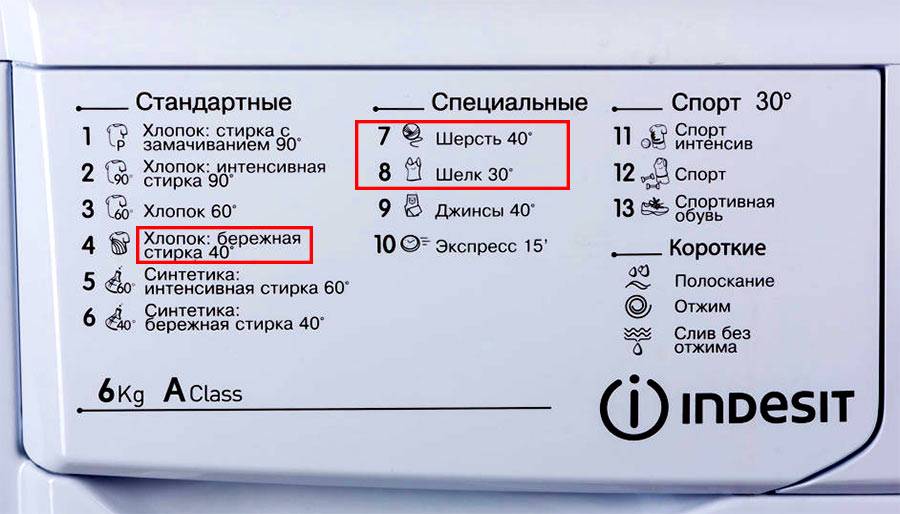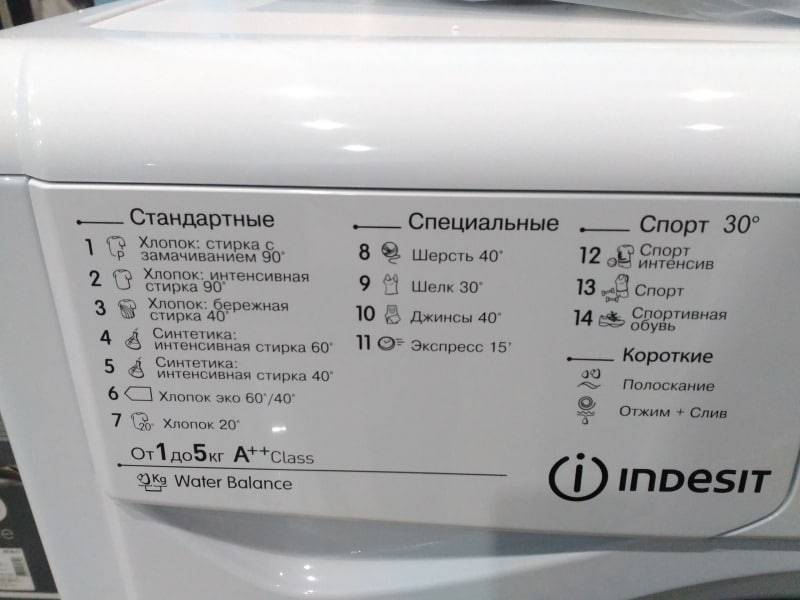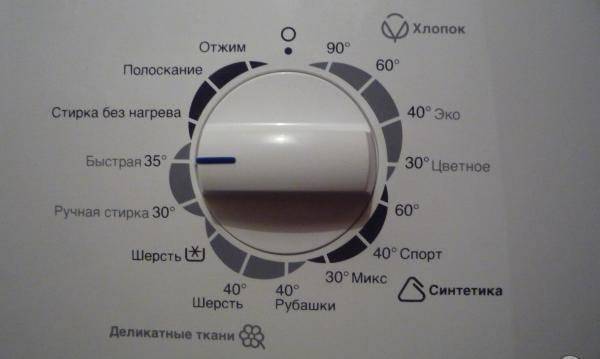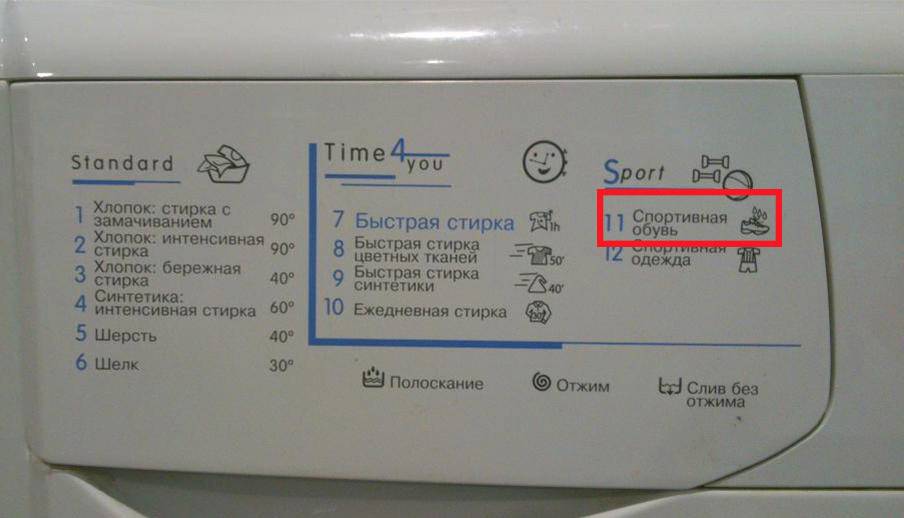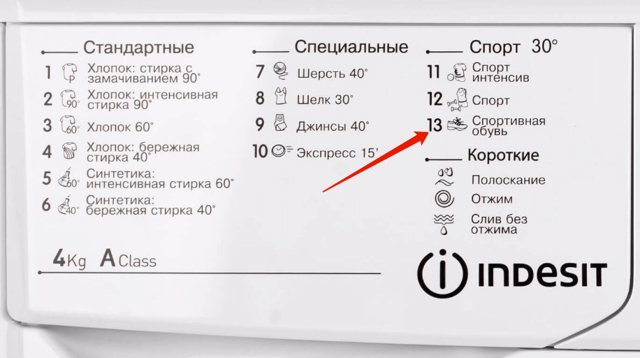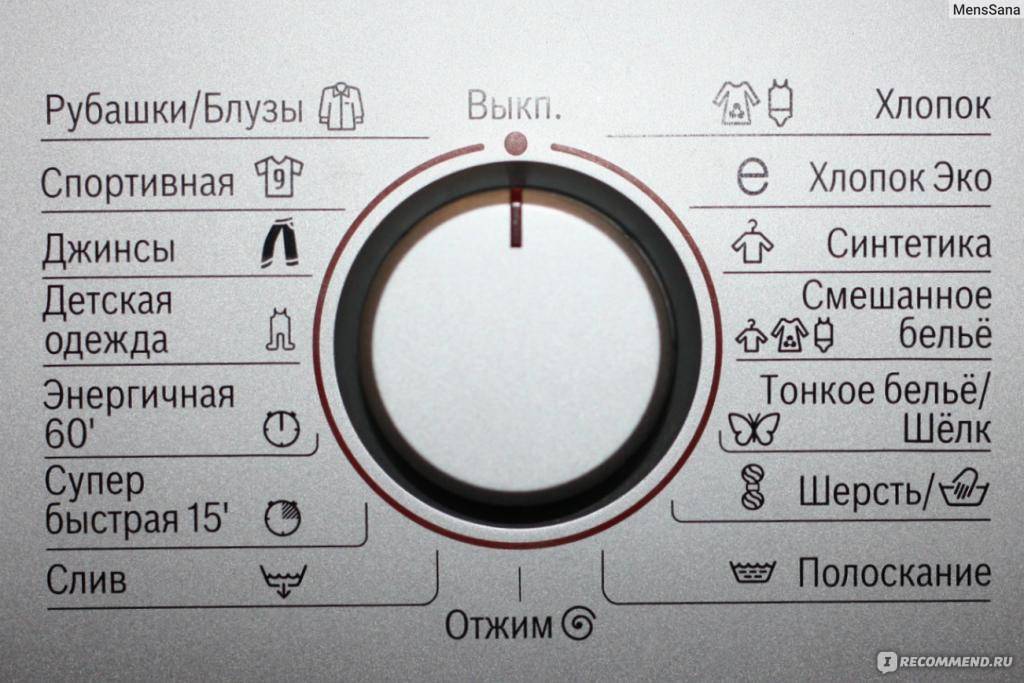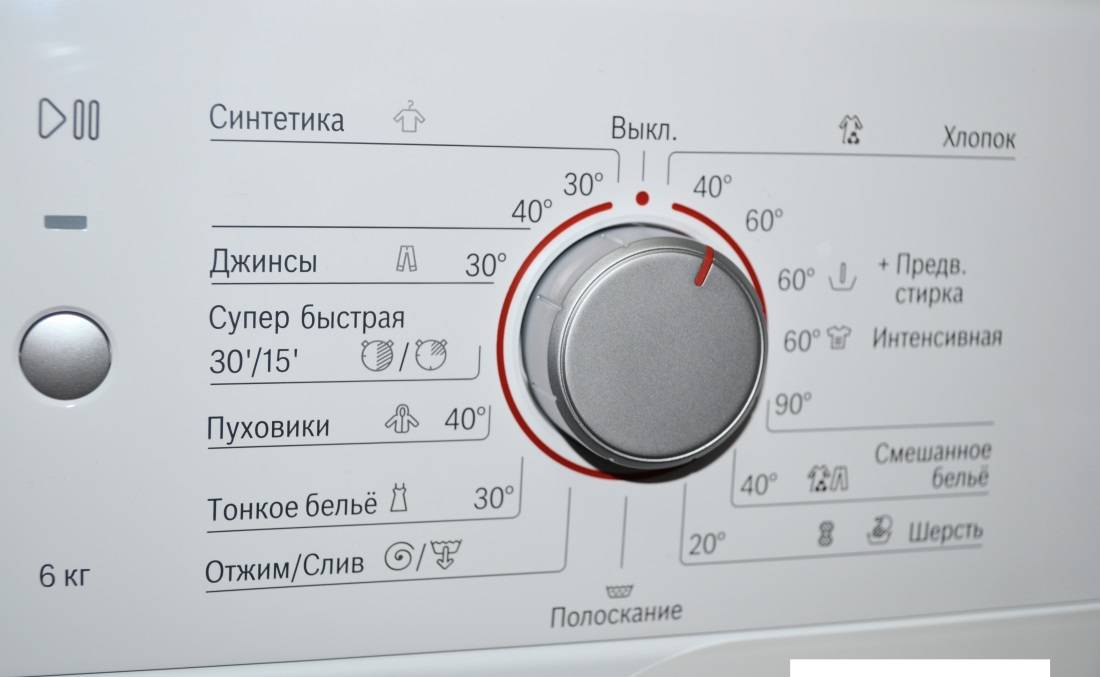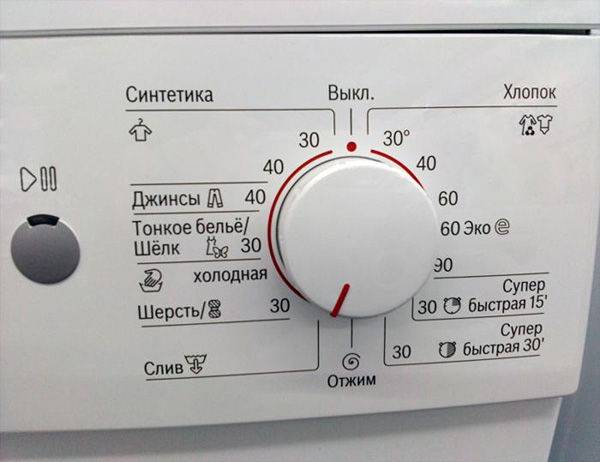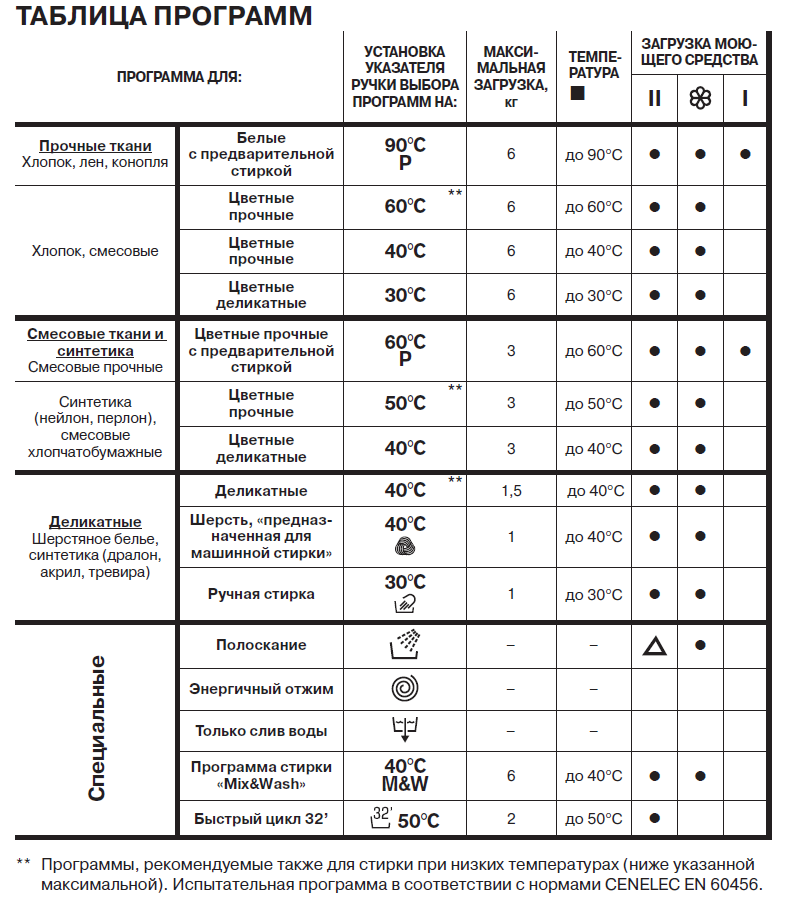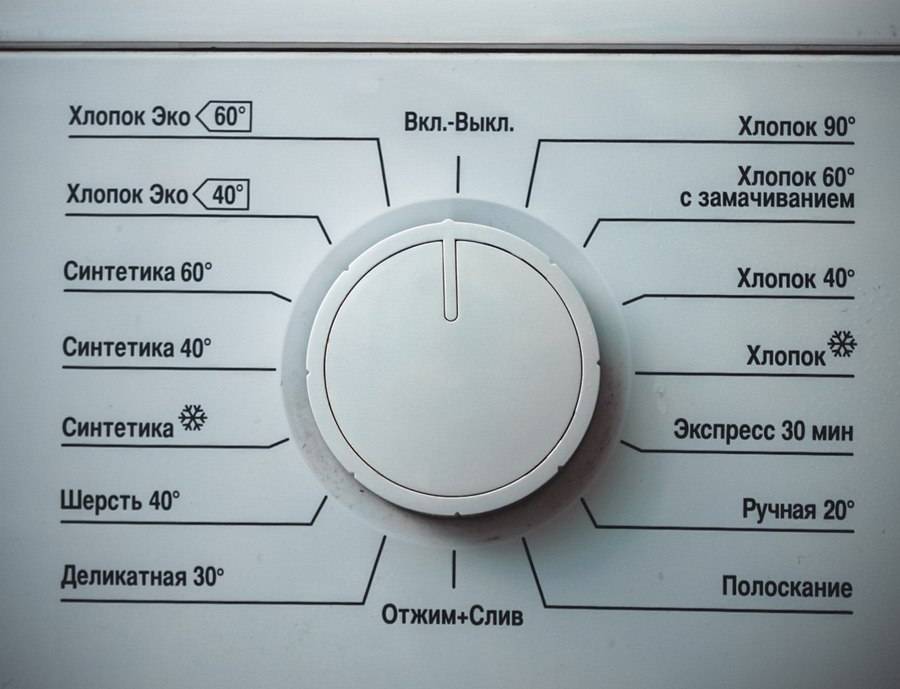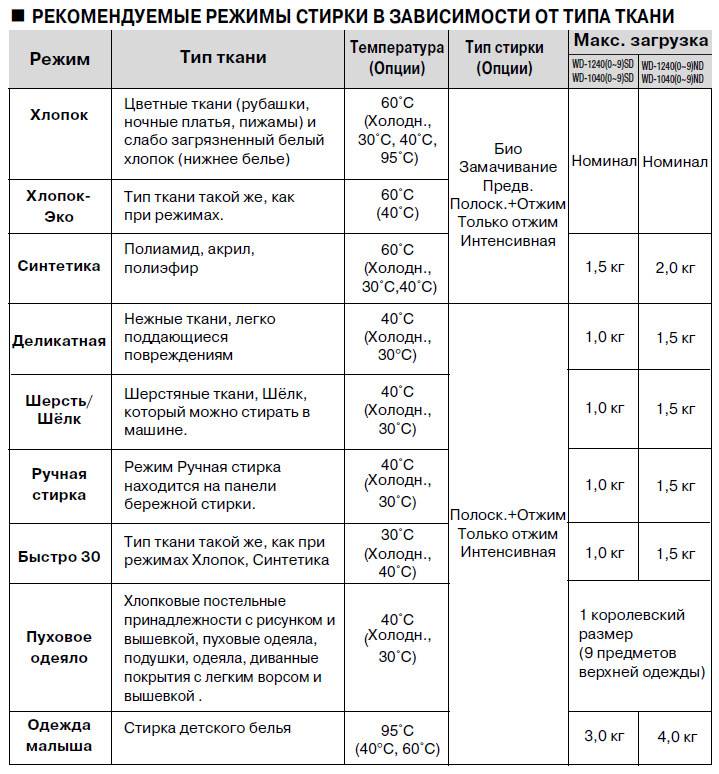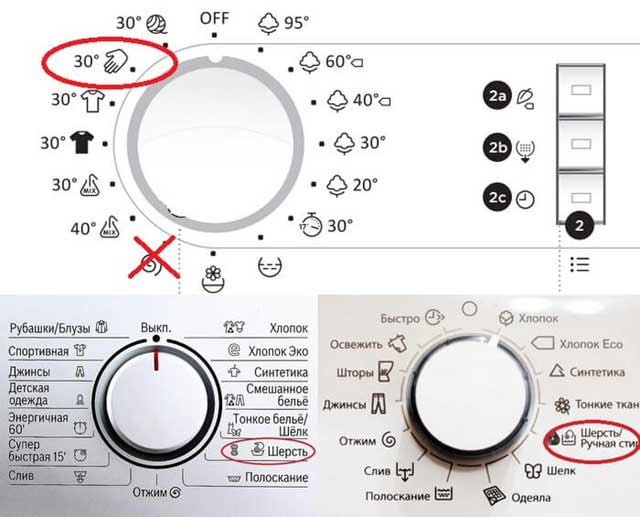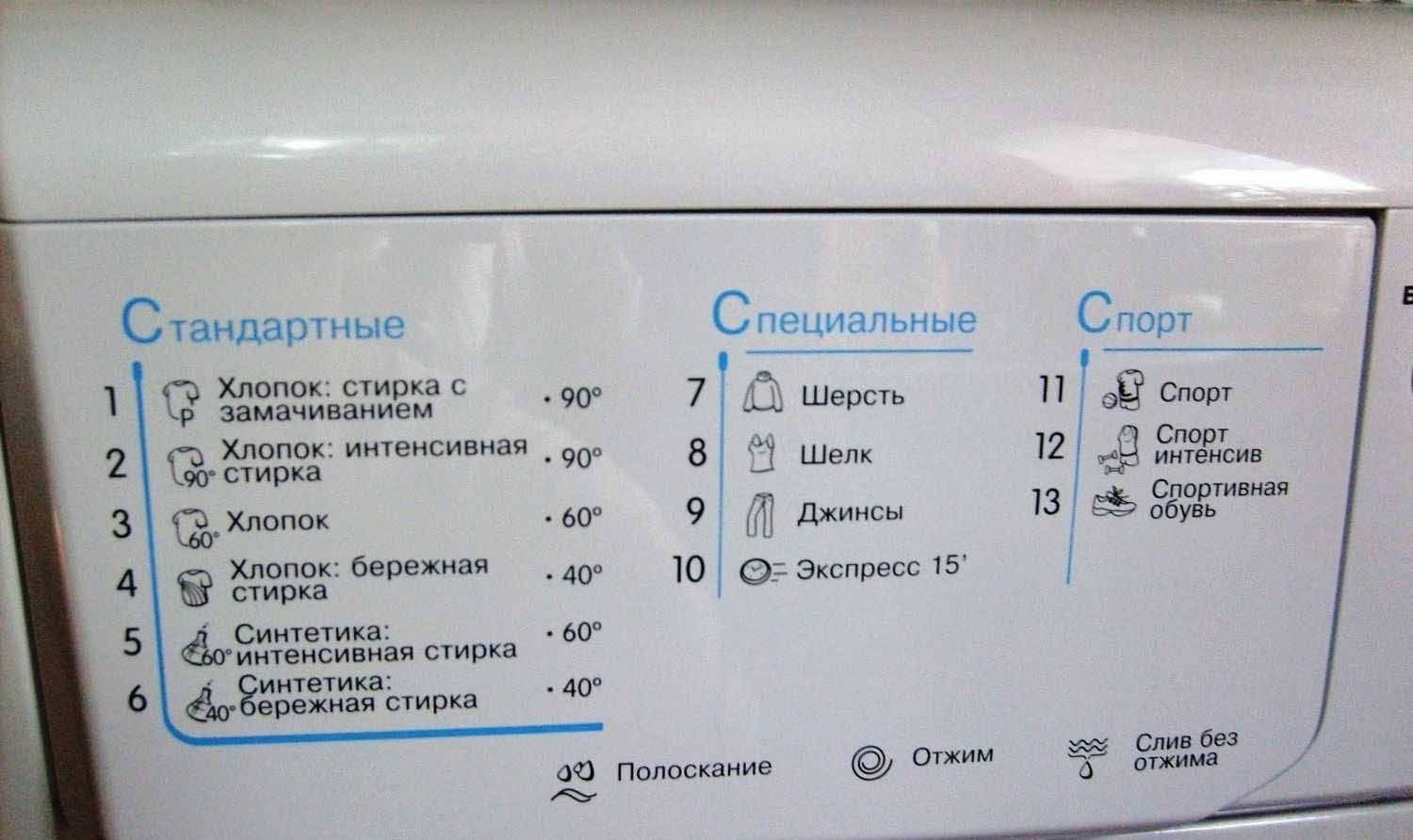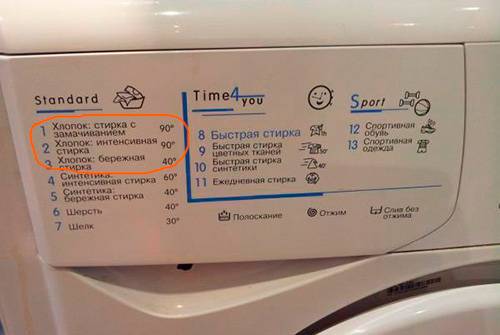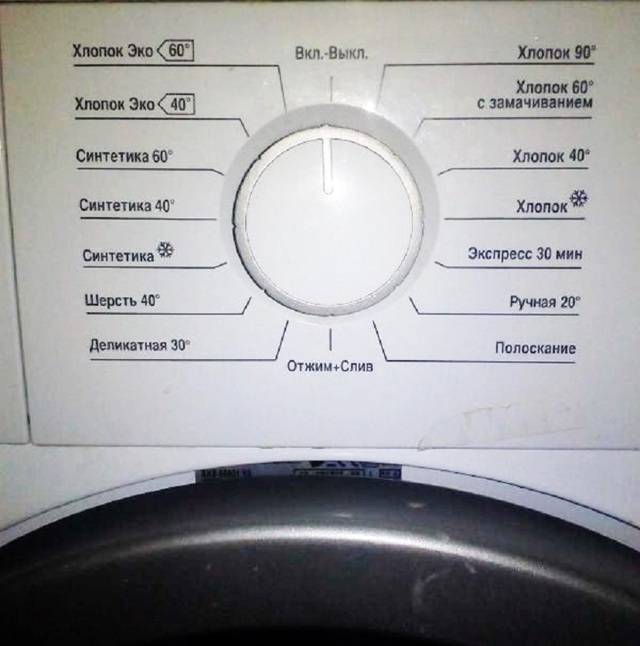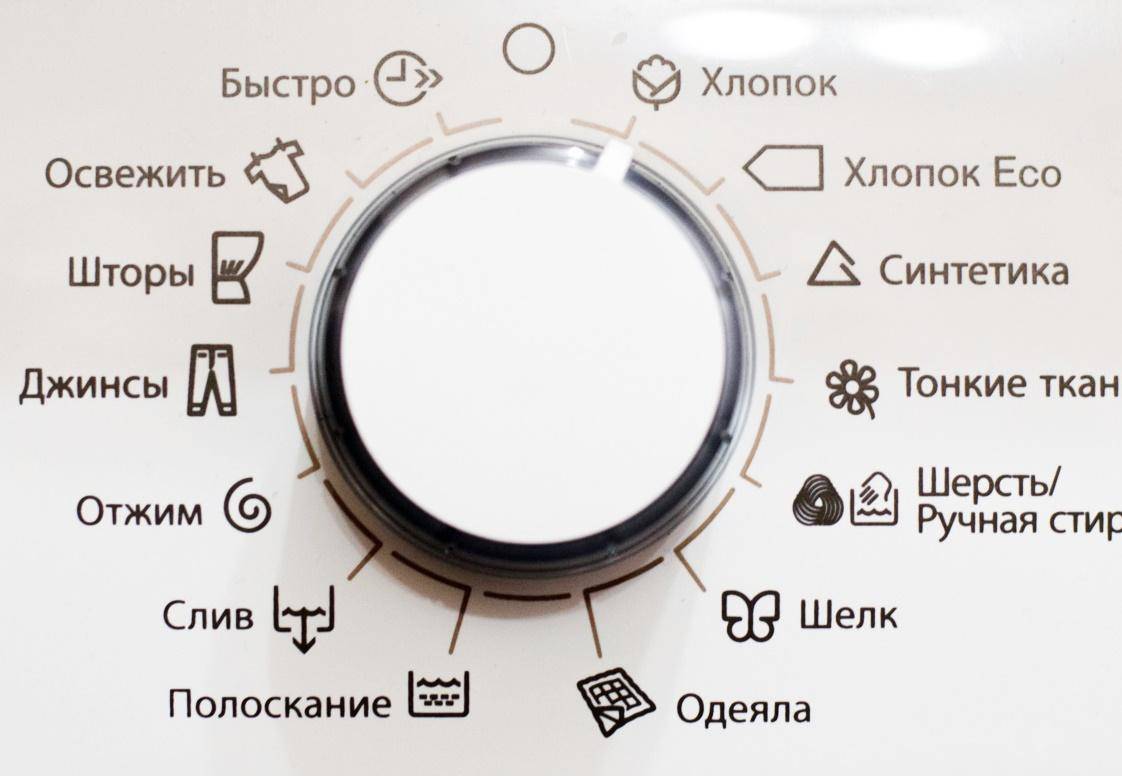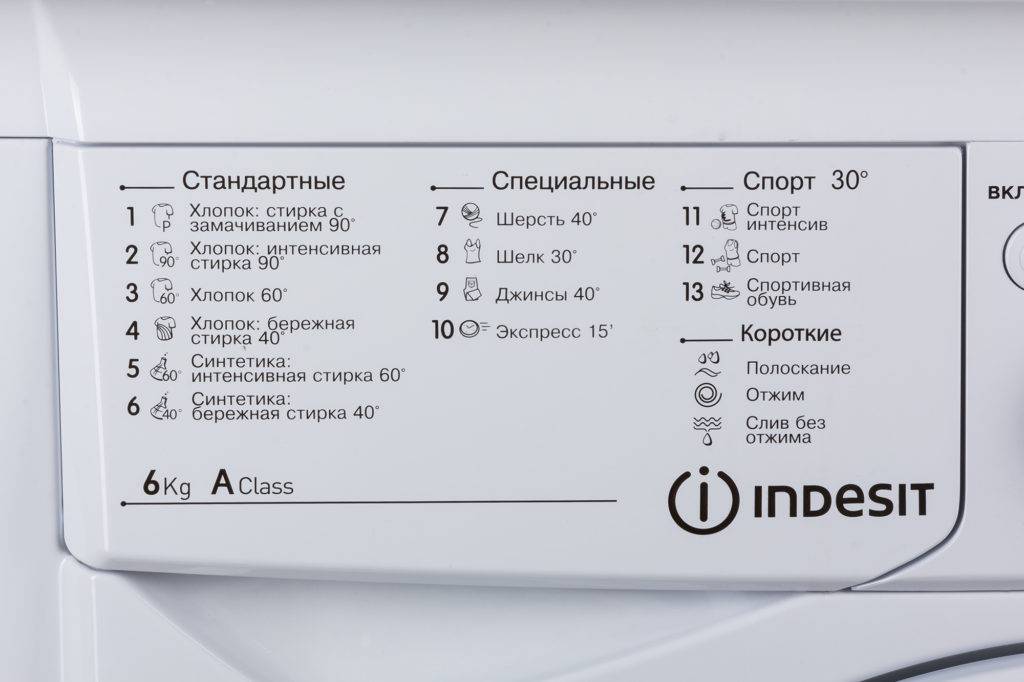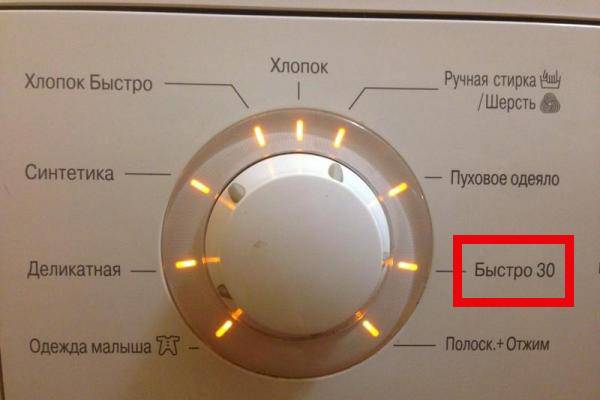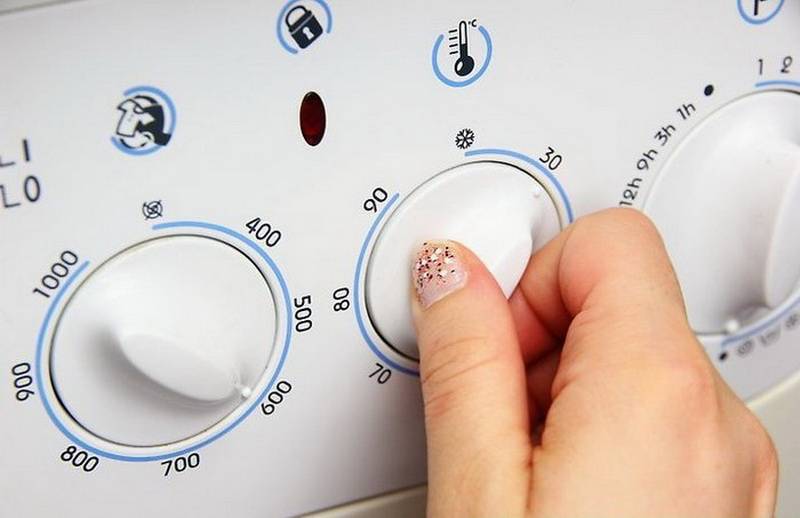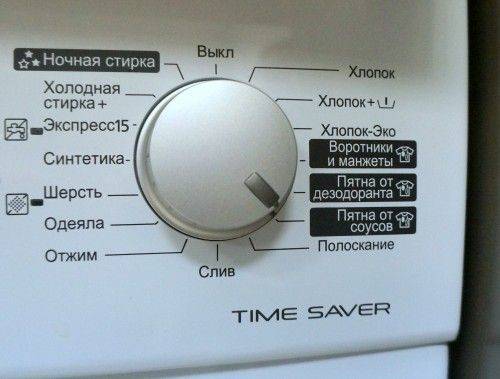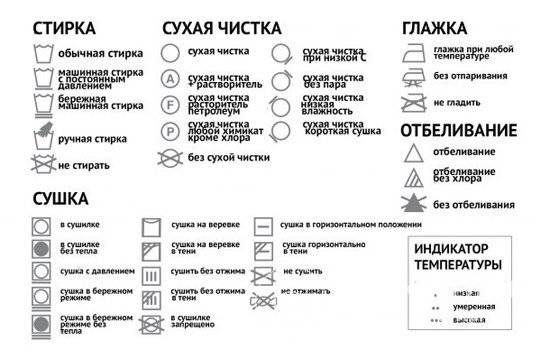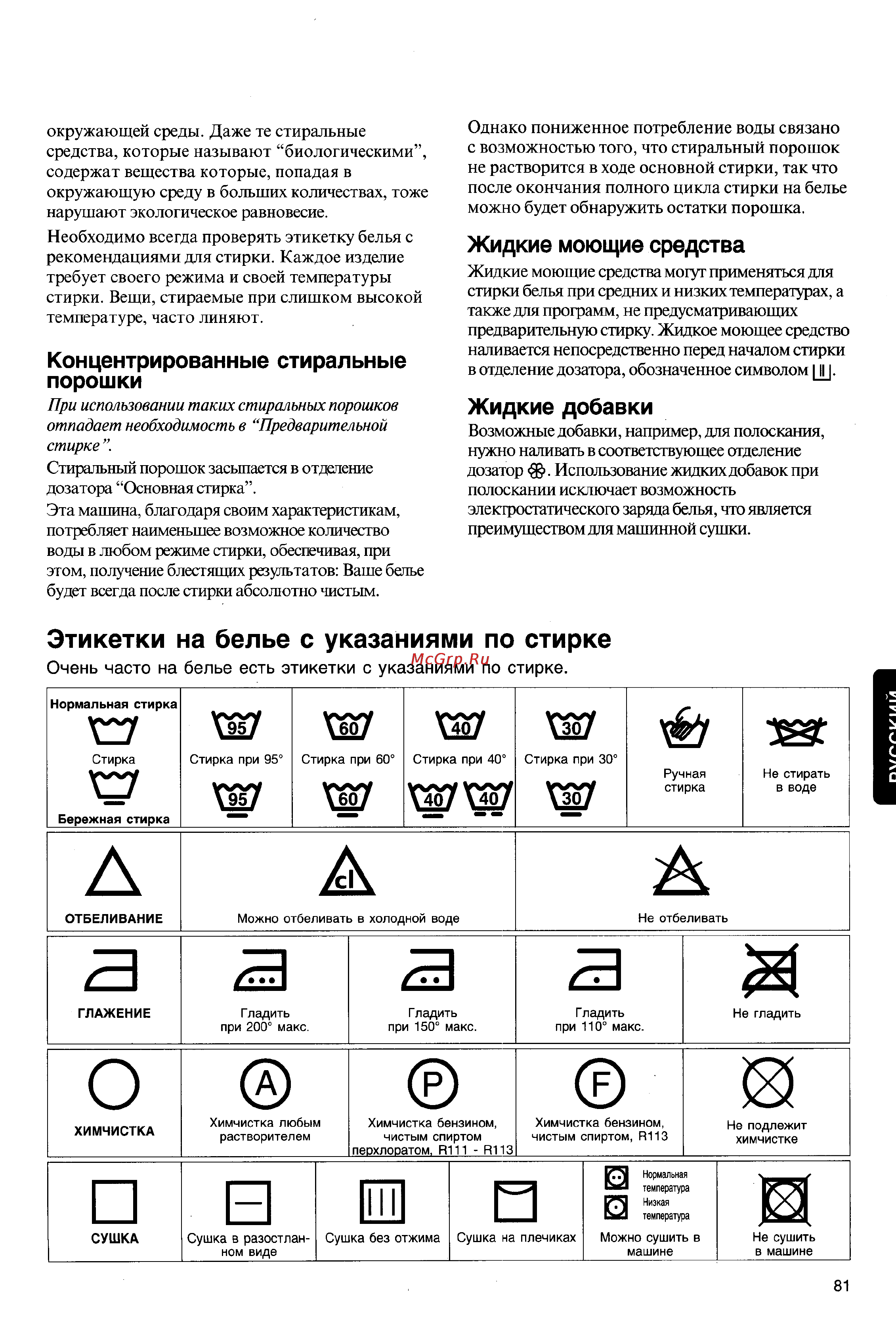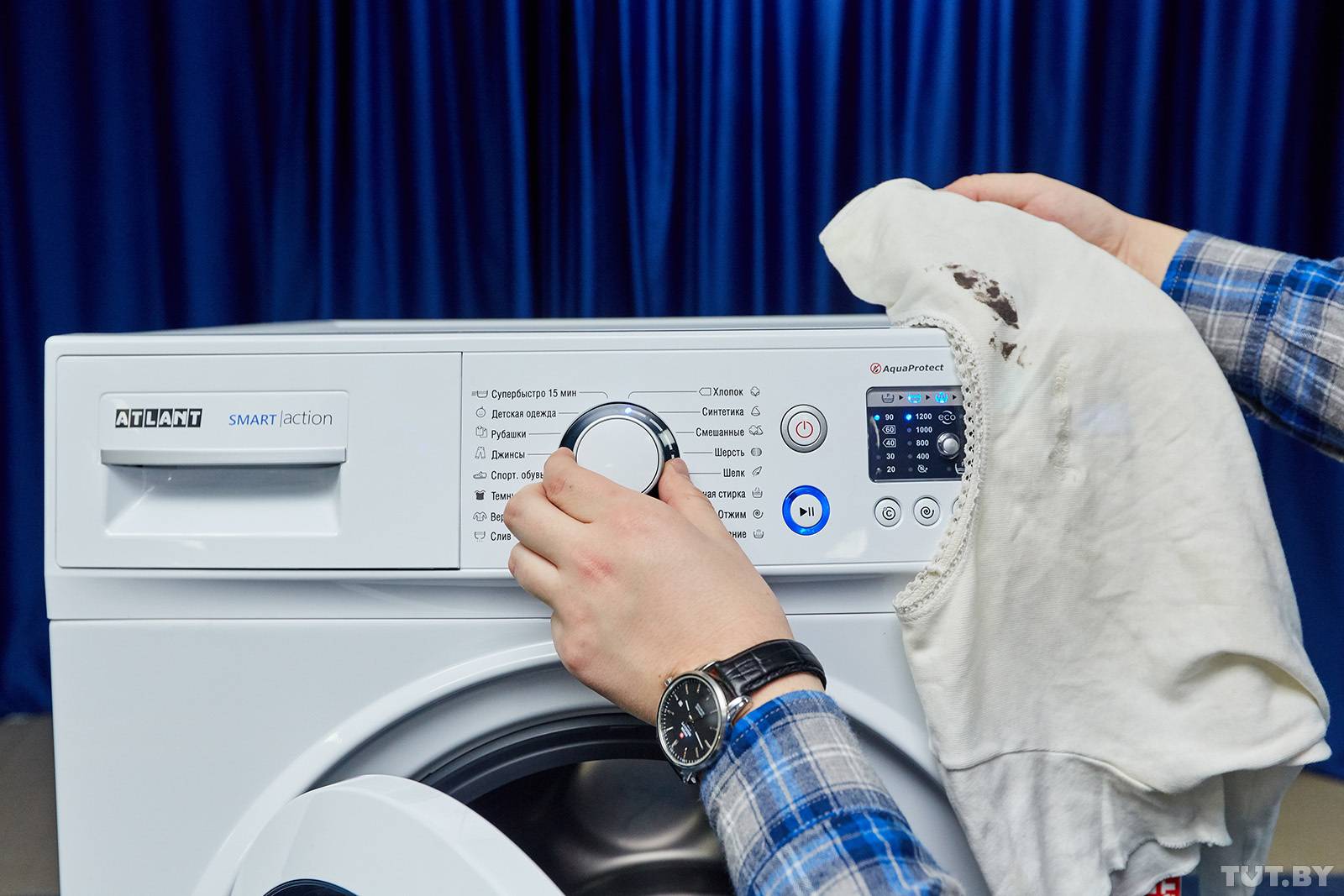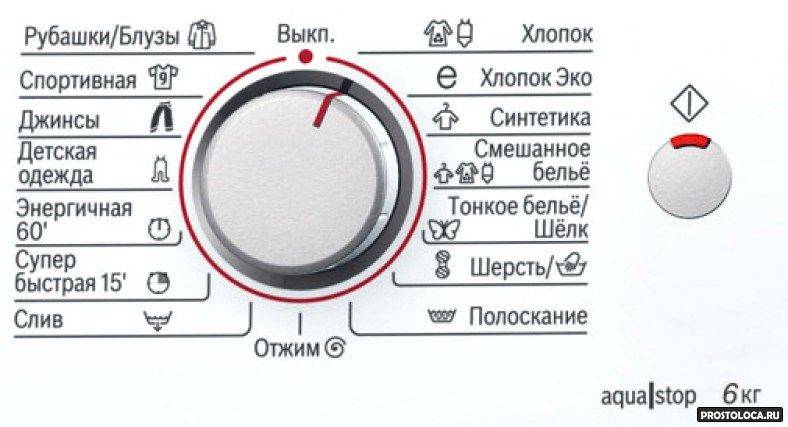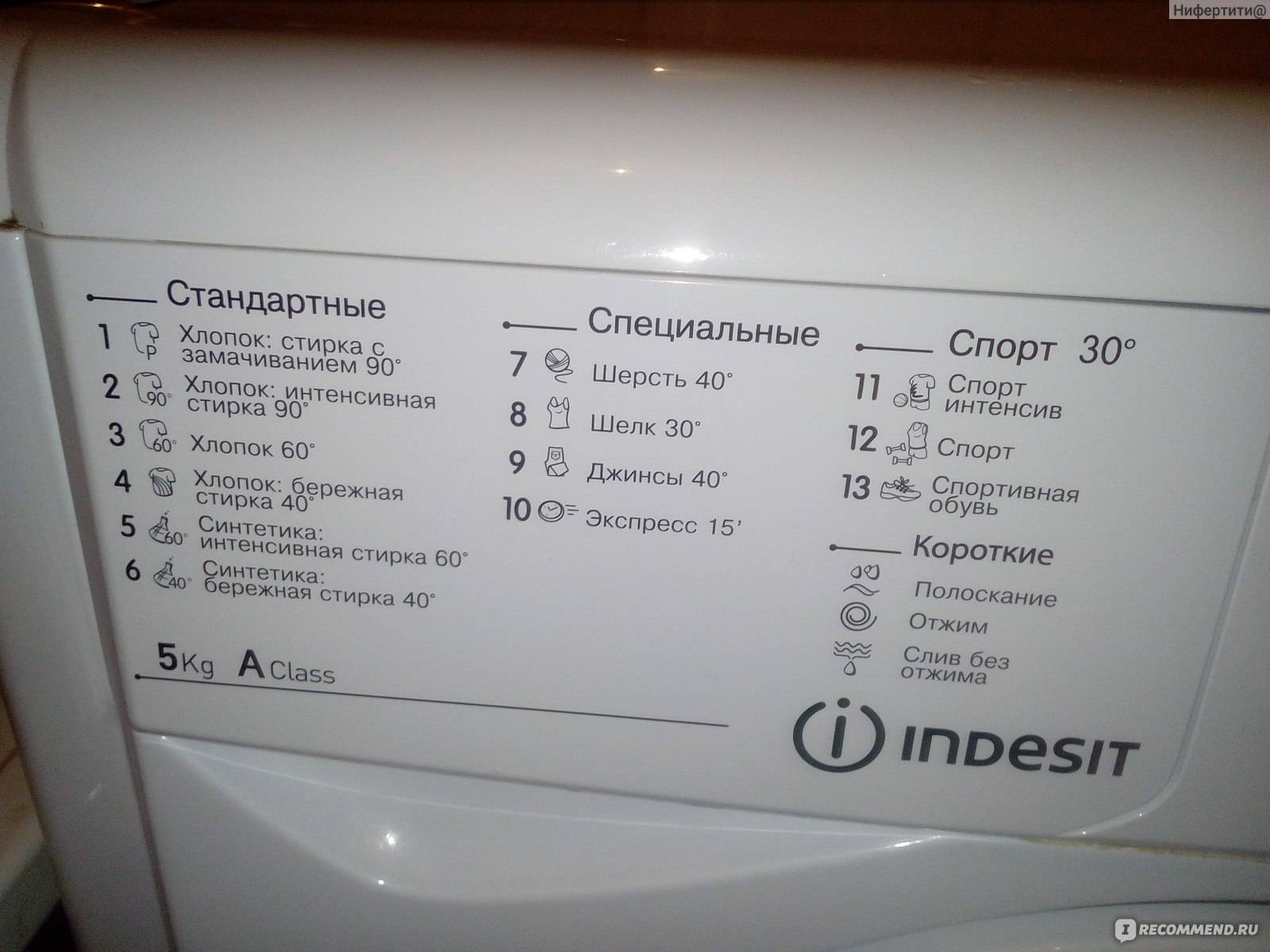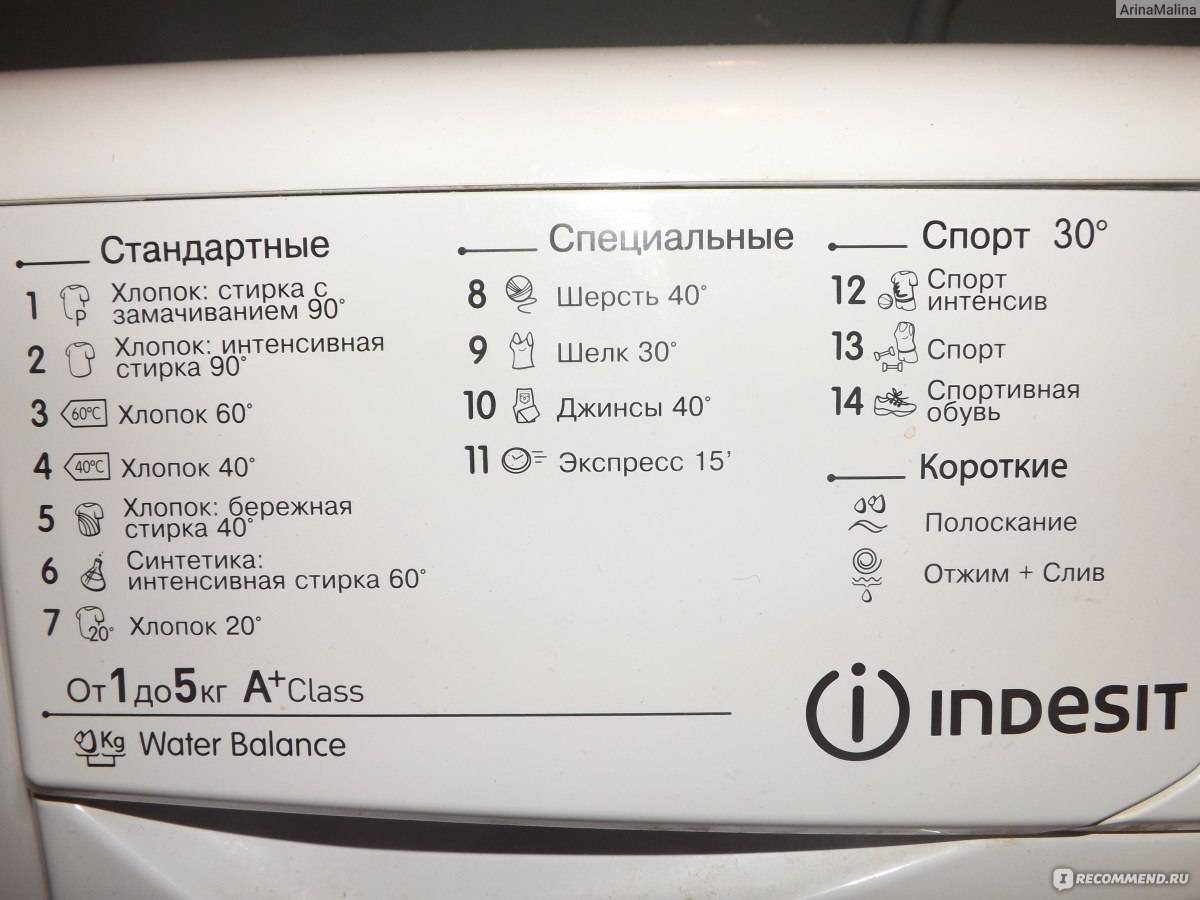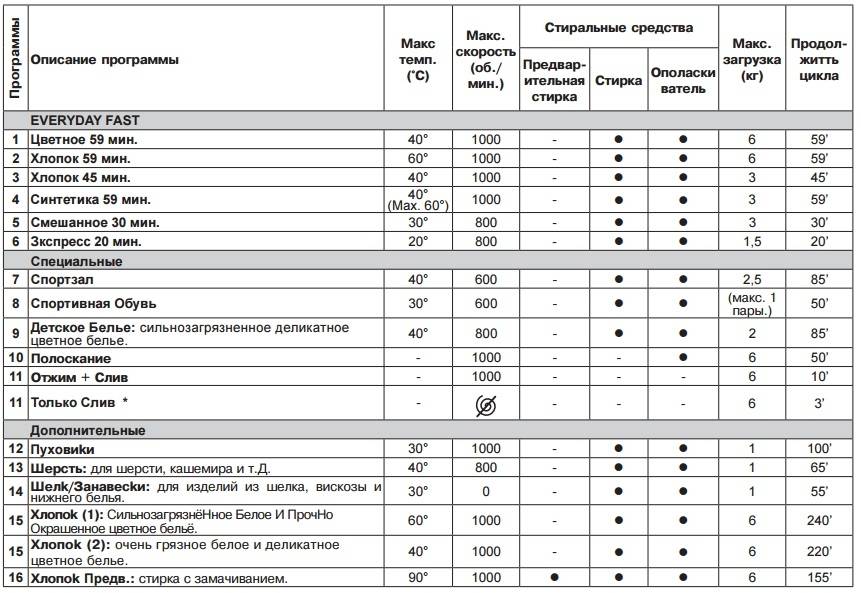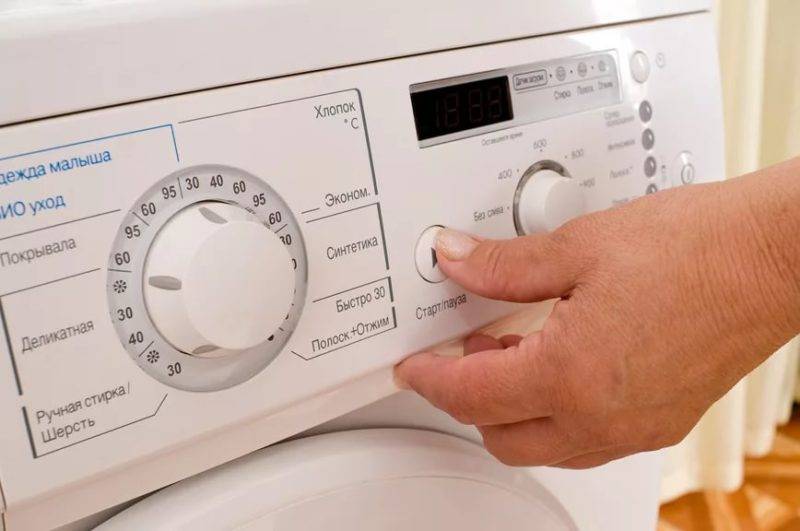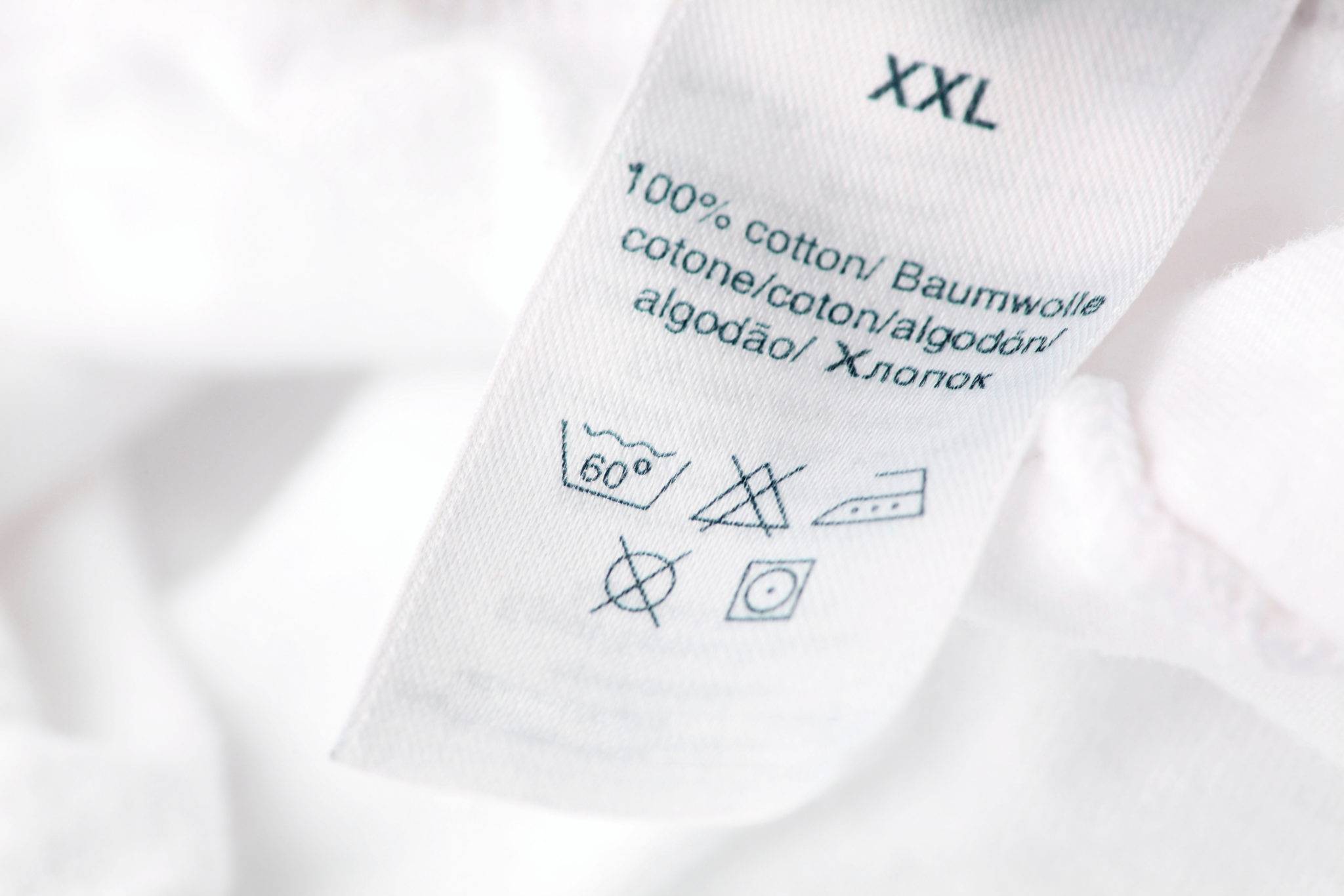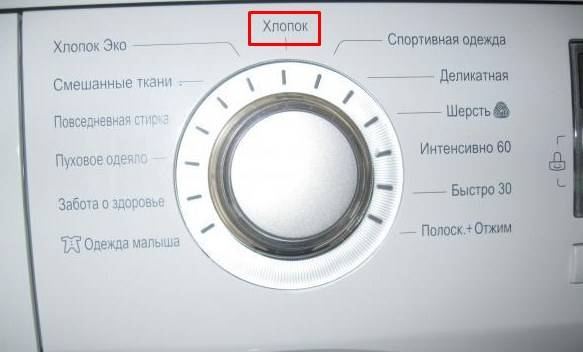Standard washing modes

The following washing modes are present practically in every washing machine... They may differ slightly in name, but the essence remains the same.
- Cotton is probably the most common washing mode that is present in every automatic washing machine. It involves washing heavily soiled bed or cotton clothes at 95 ° C. Washing is usually not fast, and when spinning, the maximum number of revolutions available to the washing machine is used.
- Synthetics is the second most popular washing program, which involves washing synthetic fabrics in a washing machine at a temperature not exceeding 60 ° C. As with the cotton program, the wash takes a long time and the maximum number of revolutions is used.
- The hand wash mode is also a very common function in the washing machine, which allows you to wash delicate fabrics very gently. For example, using this mode, it is good to wash tulle in an automatic washing machine. Typically, washing in this mode takes place at a temperature of 30 - 40 ° C. The drum rotates slowly and very neatly. There is no spin.
- Delicate wash - just like hand wash, it is intended for washing delicate fabrics, but, on different models, it can be spinned. You can read more about delicate washing separately.
- Quick wash in the washing machine - designed for lightly soiled clothes and is suitable for freshening up a wardrobe item. It washes very quickly, usually no more than 30 minutes, at low temperatures. The maximum spin speed is used. It can also be called "Express", "Daily wash", "15 Min" and the like.
- Intensive wash - as the name implies, this mode is intended for very dirty fabrics. It is not recommended to wash delicate fabrics on this program, as it is washed at temperatures up to 90 ° C.
- Pre-wash - this mode in the washing machine means two washes in a row. Usually, powder is poured into the tray in two compartments (for the main and for prewash), which is used twice. The machine washes the laundry for the first time using the powder from one section, after the end of the first wash, the second wash takes place with the powder from the second section. This program is intended for particularly dirty fabrics with stubborn dirt.
- Economical wash (ECO) - this can be either a separate mode or an additional function for standard wash programs. It is a wash in which the water is not very hot, and its use is also minimal. On it, the washing machine washes the most economical in terms of water and electricity. It is also called the eco mode in the washing machine.
- Wool is also present on most washing machines and is intended exclusively for washing woolen items. The machine, in this mode, washes very gently at a low temperature. Spin is not used.
Washing methods
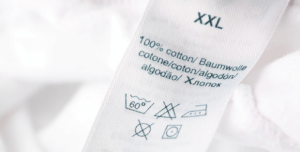 The key to the durability of a cotton product is to follow the care instructions.
The key to the durability of a cotton product is to follow the care instructions.
To prevent cotton from shrinking, you need to properly care for it. First of all, we are talking about washing and drying things. In quality items, all data is indicated on the label. There it is indicated how and at what temperature the products can be washed. It is worth studying the symbols, in the first place the temperature regime is indicated. Cotton items are washed by hand or in a washing machine, it all depends on the type of material and the level of soiling.
Handwash
Delicate products, when they get into the machine drum, quickly lose their shape and deteriorate.Therefore, it is recommended to wash them by hand. Before this, the thing must be soaked in warm water with the addition of a product.
It is important that the powder dissolves completely in the water, otherwise stains may appear. Hand washing goes through several stages:
- Soak for 10 minutes.
- Do not rub hard, but rinse a little.
- Drain the soapy liquid, rinse things in clean cool water.
- Do not wring out or twist the laundry, allow water to flow in.
- Hang on a rope, carefully straightening all parts of the product.
In the washing machine
 Household appliances greatly facilitate the daily chores of dirty laundry.
Household appliances greatly facilitate the daily chores of dirty laundry.
Cotton products take up a significant place in every wardrobe, so it is difficult to wash them all by hand. Especially baby clothes requiring heat treatment and bedding. In this case, a washing machine is used. Modern models make it possible to independently select the washing mode. Another feature: to get rid of the pungent smell of the powder, it is better to add a special conditioner.
Correct mode
Modern automatic machines make it possible to eliminate even the most difficult contamination. For this, the "clap" mode is used. It provides for a long wash at minimum speed. On average, the procedure will take about 2 hours. After washing, the spin is turned on at maximum speed. If the machine has an extra rinse function, it will not be superfluous.
Temperature
After washing, the products are able to change their shape, the reason for this phenomenon is the incorrectly selected temperature regime. The exact information is indicated on the label, but it should be understood that stubborn dirt in cool water will be difficult to remove. The minimum indicator is +30 ° C, the maximum is +95 ° C. The temperature in the washing machine is selected in accordance with the type of fabric, this is shown in the table:
| Textile | Temperature, ° C |
| White products | 35—40 |
| Dense cotton | Up to 95 |
| Colored things | up to 45 |
Handwash
To do this, fill a basin with warm water and add washing powder to it. If it is supposed to be treated with laundry soap, you do not need to use additional products.
Soiled things are immersed in prepared water and left for 15-20 minutes. After soaking, the most dirty areas are washed with a brush or hands, squeezing and releasing the fabric.
The lightest and least stained items are soaked first. After washing, the clothes are wrung out and transferred to another basin with clean water. Rinse several times until the water is completely clear. Wring out and hung out to dry.
Hand washing is the best way to clean knitwear, as it reduces the risk of ruining the garment. The process itself is extremely simple:
A capacious container is filled with cool water. Dissolve a suitable detergent in it, add soda if necessary. Immerse the item in a soapy solution, leave for a couple of minutes so that the fabric is completely saturated with water. Taking the thing in hand, they begin to gently squeeze and unclench it with their palms. The movements should go along the product, and not across, otherwise the jersey may deform. Do not rub the fabric, try to remove stains and heavy dirt with a brush - after that, pills form on the knitted fabric. After washing, the item is thoroughly rinsed, changing the water several times until the soap solution is completely washed out of the fabric.
It is important that the rinse water is at the same temperature that was used during the wash - after contact with a colder or hotter, the product may shrink. To make things soft, you can add a teaspoon of glycerin to the rinse water.
It is impossible to twist the jersey, trying to remove excess water. Before hanging the clothes to dry, you need to gently squeeze them with your hands with gentle movements. Start from the top (the neck of a sweater, for example), moving to the bottom. After that, it is spread on the grate above the bathtub so that the remaining water drains.If there is no grate, spread a towel on the table, put the washed item on it, roll it up and wring it out. Hanging a wet knitted product on a rope or hanger is not allowed, the damp fabric will stretch a lot.
How to wash a thing so that it does not shrink: recommendations
How to wash cotton items in the washing machine and by hand to prevent them from shrinking?
In the washing machine
It is easiest to wash cotton in a washing machine, you just need to choose the right mode and temperature. To get it right, you can follow a step-by-step guide:
- Sort items by color and degree of soiling.
- Put it in the drum.
- Add the required amount of powder.
- Set the temperature from 40 to 90, spin speed 500-800 rpm. Select "Cotton" or "Delicates" mode.
It must be remembered that cotton shrinks not only from high temperature, but with a strong spin, therefore, it is recommended to choose the maximum values only for coarse fabrics, bed linen.
- It is recommended to use a double rinse for the laundry to completely remove the powder.
Manually
They wash delicate items, delicate clothes and linen with their hands. You should not pour water with a temperature above 40 for this.
The process of washing such things is not complicated:
- First, dissolve powder or shavings of laundry soap well in water.
- Dip the item into the solution, leave for 10-20 minutes.
- Rinse gently with your hands, being careful not to rub or pull on the fabric.
- Rinse several times to completely remove the detergent.
- Add a little conditioner or vinegar for the last rinse. This will make things soft.
- Do not twist too much, just squeeze out a little, then straighten and hang to dry.
Handwash
Simple recommendations: • First, soak the item in hot water. The temperature should be 15-20 degrees higher than indicated on the tag • Wait until the water becomes warm • Slightly wring out the clothes and put them in a bowl of very cold water • Rinse everything thoroughly and lay out to dry • If you wash with a washing machine, then set the temperature to no more 60 degrees • For spin, select the standard mode
Every good housewife tries to keep the towels in her house clean and fluffy. But sometimes, literally after the first wash, this product becomes tough and prickly. Usually women write off everything on not very high-quality material. Of course, this can also be the reason for the stiffness of the towel, but in most cases, washing affects the softness of the towel. If, for example, your water is not quite soft and you cleaned your laundry without softening agents, then whatever you do, your towels will not be fluffy.
Tips to help make towels fluffy: • Use only liquid detergents for cleaning • Do not wash in Economy mode • Never bleach towels • Use a stain remover to remove stains • Place a down ball in the drum with the towels • Spin at the lowest speed • After washing, rinse the garment with softener water
Things can be whitened with:
- Bleaching agents (oxygen, optical, chlorine).
- Soda
- Hydrogen peroxide
- Whiteness
- Ammonia, etc.
As a rule, cotton shrinks slightly and returns to its original size after the first wear. If there is a global nuisance, you need to re-wet the fabric in warm or hot water, stretch it on an ironing board and iron it until completely dry.
You can wash cotton to shrink in hot water. It is best to use boiling. After the end of the procedure, use special forceps to remove the tissue from the container and move it into a basin with cold water. The temperature difference contributes to the shrinkage of the fabric.
How to remove stains of blood, fat, grass?
Stains are more difficult to deal with.To remove them, you can use industrial stain removers or folk remedies.
You can use one of the most common methods:
- Dissolve in 5 liters of hot water 2 tablespoons. any cotton detergent. Better to choose those that contain optical brightener or stain remover. Keep the item in the solution for at least 3 hours.
- Dissolve a quarter of a bar of laundry soap in 5 liters of water. Grind it beforehand. The solution is suitable for soaking delicate fabrics.
- If you add 9% vinegar to the saline solution, you can soak colored chintz and jeans. Proportions for 10 liters of water 5 tablespoons. vinegar and 3 tbsp. salt.
- Blood stains should be washed in cold water. Then lather with laundry soap and leave for half an hour.
- To get rid of greasy stains, apply a mixture of grated laundry soap, ammonia and turpentine to the fabric. The proportions are 2: 1: 1.
- Clothes soiled in the grass should be washed with laundry soap. If it does not help, pour hydrogen peroxide on the stain, sprinkle soda on top. Then rub a little with a soft brush.
- To remove stains from brilliant green, you need to rub the fabric with a solution of alcohol with lemon juice or ammonia.
Blood stains are soaked in cold water; Domestos can be used on white cotton cloth. They hold it for a while, then wash it off. You can use regular laundry soap.
- Greasy stains. We take a paper napkin, heat up the iron and iron the thing well. As it gets dirty, we change the piece of paper to a cleaner one. You can wash your item with dishwashing detergent. For cotton, you can use a gruel consisting of shavings of laundry soap, ammonia, refined turpentine (2 to 2 to 1). Apply to the fabric, wait until the composition dissolves the stain within two hours, soak and wash.
- Ballpoint pen marks are removed using a mixture of ammonia (4 ml) and a glass of warm water. After that, the mixture is applied to the stain. For colored fabrics, a mixture of turpentine and ammonia (2 ml of each component) is suitable.
- Wash off yellow perspiration stains with a solution of ¼ cup salt and hot water. Then the item is washed as usual.
- Rust stains are removed with a toothbrush and soap. If the stain is not strong, it can be easily removed with lemon juice. The garment is moistened with lemon juice and ironed with a hot iron with a steaming function. Old stains are eliminated with a citric acid solution (for 250 grams of water, a teaspoon of powder).
How to choose a detergent
The fabric of the curtains is light, so the rate of the detergent is reduced by 2 times. When washing in a machine, the rinse program is run 2 times to completely remove the chemical residues.
Detergents by type of fabric
To wash expensive curtains, modern curtain detergents with low foaming, phosphate-free are purchased.
Suitable for products made of organza, cotton, nylon.

Silk balm
Silk tulle cannot be washed with regular powder. Enzymes and alkalis affect the fiber structure. For delicate fabrics, liquid products are suitable, which have a mark - for silk and wool.
Popular choice
Experienced housewives choose the most reliable washing powders and gels.
Cashmere Elixir for tulle and curtains
Powder for delicate fabrics (artificial, natural) removes traces of soot, soot, nicotine, fat. The composition contains silicones. They prevent wrinkling. The powder is intended for all types of washing, white and colored curtains.
Clovin clever gardinen
They wash white curtains from any fabric on their hands. The powder removes grease stains, traces of soot, soot, removes unpleasant odors, restores whiteness.
Choosing a detergent
It's not enough to know how to wash a T-shirt
Equally important is information on how to choose a detergent. Basic selection rules:
-
If you are using sti
powder, choose it depending on the type of wash (it can be hand or machine). If you wash with both hands and a typewriter, then you can pick up a universal powder.
- There are products on the market for various types of fabrics, such as delicates, woolen or colored fabrics. It is best to be fully armed and have several options in stock in order to wash any thing without consequences.
Washing powder is not the only one, and in some cases it is not the best option. Its granules can corrode fine or delicate materials. To avoid such troubles, purchase a liquid detergent composition. Concentrated gels are especially effective. Some of them can be used for both hand wash and machine wash.
A stain remover will help get rid of stubborn dirt. But the funds belonging to this category are very aggressive, so their choice should be approached responsibly. The best option is an oxygen stain remover, which contains special ingredients that release oxygen and literally break stains into small particles.
Cotton machine washable
Only delicate cotton items need hand washing. Regular clothes and natural textiles are allowed to be washed in the washing machine. To prevent its shrinkage, the appearance of pellets and loss of color, you need to follow some simple rules.
Preparing for washing
Preparing cotton items for machine washing will be similar to preparing them for hand washing. Products are sorted into:
- white and colored;
- heavily polluted and slightly polluted;
- needing pre-soaking or not needing;
- requiring the use of a stain remover and not requiring.
Next, the pockets are checked, things are turned inside out, all buttons, zippers and fasteners are fastened. If necessary, you can use mesh bags to prevent things from getting into a lump when the drum rotates.
Washing mode
It is important to select the correct washing mode for cotton clothes and linen. Modern washing machines can have either one Cotton program or several of its varieties:
- colored cotton;
- heavily soiled cotton;
- cotton. Quick wash, etc.
Each program has its own washing duration. In order not to be mistaken with the choice of the desired mode, study the instructions and rules for using your model of the washing machine.
Washing temperature
Different water temperatures are used to wash cotton effectively. Her choice will depend on what exactly you are washing:
- white bedding and tablecloths - water temperature close to boiling;
- colored fading laundry - no higher than 40 degrees.
The washing temperature is an important parameter on which the freshness and cleanliness of the products will depend, as well as the elimination of the risk of loss of color by the fabric and its shrinkage.
Even a young housewife can figure out the simple rules of washing cotton linen. Automatic washing machines and special products for natural fabrics will help her in this.
Wash colored cotton clothes at a temperature not exceeding 40 degrees, choosing the optimal mode for this provided by your washing machine. Choose appropriate products for white laundry and hand wash delicate items. This will preserve the freshness and brightness of the fabrics, their aesthetic appearance and original shape.
Preparing for washing
Before starting the wash, it is important to familiarize yourself with the tags on the clothes and make preliminary preparations.
The first step is to empty the pockets, fasten all the zippers and buttons. The clothes should be turned inside out to help maintain their appearance. The next step is to carefully decompose things into two heaps: white and colored
It is important to keep in mind that if at least one, for example, a red sock accidentally falls into the wrong basket, things from another after washing will take on a pinkish tint.To remove stains as much as possible, you need to choose the most soiled items for additional soaking.
- We sort things, separating white from color, so that they do not stain;
- We select linen with heavy contamination;
- Laundry with stains is pre-soaked;
- Things are turned inside out, all zippers are fastened on them.
Sorting is carried out by type of material. Thin and colored cotton fabrics give strong shrinkage, they are recommended to be washed at 30-40 degrees.
A very important stage of washing is preparing things. This will help avoid warping and discoloration. If colored laundry is washed with light colored items, it may shed.
Before putting cotton linen in the machine, you need to do the following:
- separate things by color, separately white linen (read about washing white linen here), separately colored;
- sort them according to the degree of soiling; heavily soiled or stained items are washed separately;
- it is recommended to turn the clothes inside out, fasten all zippers and buttons, and empty the pockets;
- it is better to put small things in mesh bags, it is also recommended to wash duvet covers in them, this will prevent other linen from getting inside;
- if the thing is being washed for the first time, you need to carefully study the label, it indicates at what temperature you need to wash, how to dry and iron it correctly.
More severe treatment is required for stained laundry. To remove them, it is recommended that you remove them first. To do this, the thing is pre-soaked for several hours.
How do I fix the error?
The choice is made by a person, and it is common for him to make mistakes. What to do if you started the machine and after a while realized that you chose the wrong settings. Many users are interested in whether it is possible to change the mode during washing. How do I disable the wrong program? Proceed like this:
- press the pause / stop button;
- keep the button pressed - for about 5 seconds.
The settings will be reset, and you can put another option. There is another way to reset - restart the CMA. But be sure to read the instructions on how to do this correctly so as not to harm the electronic module.
Useful video:
Choosing the right program is half the battle. You can not only wash things with high quality, while maintaining their attractiveness and integrity, but also save all types of resources - time, electricity, water, detergents.
Badly
Interesting
13
Super
4
Features of hand wash
This fabric is perfect for summer, because it allows air to pass through and does not allow sweat to accumulate. But its disadvantage is not only that it wrinkles a lot. From the heat, ugly yellow spots, traces of smudges may appear. There are ways to combat them, such as lemon, vinegar, or eggshells.
When hand washing, you can also not experiment, it is best to heat the water no higher than 40 degrees. It dissolves a special powder intended for cotton fabrics. You can also coarsely grate 2 tablespoons of laundry soap. The product is soaked in the composition for 10-15 minutes. Cleaning after washing takes place several times in cold water.
If the dirt is strong, then the thing is soaked for 5 hours in water with washing powder. Handkerchiefs and baby diapers are perfectly washed if they are immersed in salted water for three hours before the actual process (3 tablespoons per 3 liters of water).
Results for stubborn stains
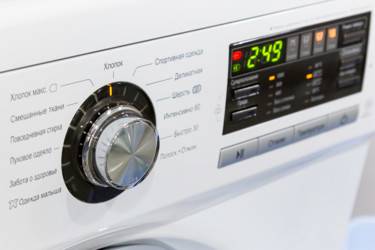
Ink, tomato paste, shoe polish and lipstick are traditionally considered the most difficult stains. It is by them that you can determine the effectiveness of a washing machine or washing powder. Therefore, in the table below, we have specially deduced the results for these types of pollution separately.
A temperature of 60 degrees and a load weight of 60-70% of the maximum allowable is the optimal combination for washing even heavily soiled cotton in any modern washing machine.
“Low temperature programs are more suitable for everyday life and light pollution. These wash programs extend the life of the textiles. In addition, these programs serve global energy conservation and environmental protection. High temperature programs are applicable for hygienic purposes. If you have a child or pets, using high-temperature washing modes, it is possible to eliminate microorganisms, fungi, mites, cat and dog hair allergens. Using high temperature programs does not always mean better wash performance. Because the working mechanism of detergents can vary at different temperatures. "
“For effective removal of bacteria and allergens, a temperature of 60 ° C is sufficient, but at the same time the duration of the processing of the laundry must be long enough, so many manufacturers develop special programs that withstand the necessary time parameters at a temperature of 60 ° C to achieve the desired hygienic result. At 90 ° C, the processing time for the anti-allergy effect is significantly shorter. If the washing machine does not have a special hygiene program with a set temperature of 60 ° C, we recommend washing at 90 ° C. In addition, there is a strong belief among consumers that hygienic processing requires a high temperature - to meet the needs of such consumers, there is a program for washing cotton at 90 ° C. "
“Washing at a temperature of 90-95 degrees essentially replaces the boiling process, and boiling, as you know, is performed for intensive processing of fabrics for the purpose of disinfection. Thus, the option of washing at 90-95 degrees will be very useful for washing clothes for newborns, for processing bed linen, for example, during periods of infectious diseases, for washing clothes in cases of skin diseases, for washing medical cotton products, as well as for washing soft toys ".

